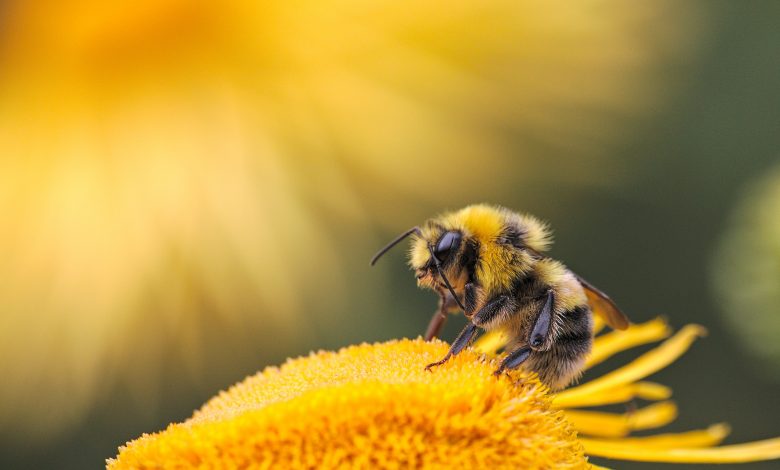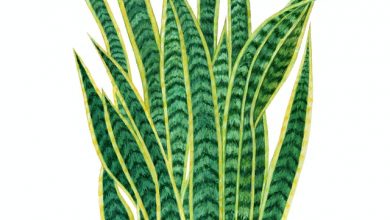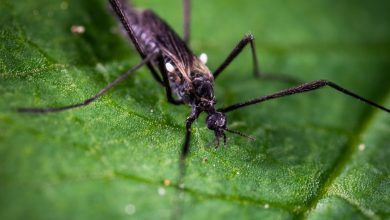How to Create a Bee-Friendly Garden

Gardens aren’t just nice to look at – they can also do this planet a lot of good! Aside from looking gorgeous and smelling nice, the right garden can also assist the creatures on our planet who rely on flowers the most.
It doesn’t take someone with a green thumb to know that bees need us now more than ever. If you’re planning your next planting season, you might be wondering how you can help bees in the garden. Fortunately, there are all sorts of ways to help these pollinating powerhouses!
With so many things you can do, consider some of the following garden tips to help encourage the bee populations in your garden.
Declining Bee Population
There’s no doubt about it: Bees are a key pollinator in our world. We rely on them to facilitate the growth of many of the plants we enjoy and a large portion of the foods that we consume (including fruits and vegetables!) Without these buzzing pollinators, we would have to say goodbye to almost $215 billion worth of food worldwide.
We need these delicate insects, but trends have revealed that we’re losing bee populations in alarming numbers. These important creatures have been diminishing because of a range of factors, including pesticide use and habitat loss.
Although many people are passionate about changing our harmful ways, it’s safe to say that pesticide use is still heavily used by large corporations. That being said, growing a garden is important now more than ever; bees can use all the help they can get.
Flowers to Grow for Bees

Cosmos
Cosmos are the most commonly suggested flower to feed bees. They are half hardy annuals, and they’re one of the most preferred flowers for a variety of bee species.
Cosmos are large, flat flowers, often seen in pink and purples shades. Their shape makes them easy for bees to land on; plant them in large groups to give the bees more food to eat without having to fly so far.
Asters
Similar to the Cosmo flower, Asters are a large, flat flower that commonly comes in pinks and purples. They are half hardy annuals that should also be planted in large groups to be the most effective.
If you’re growing a bee garden, be sure to pay attention to your asters. When the center of the flower is yellow, they’re still providing pollen to the bees. Once they lose their vibrant yellow color, there is no more pollen to be had. To counteract this, consider planting asters at different times, so that you always have asters that can provide bees with their food.
Lavender
Not only is lavender beautiful for your garden, but you’ll see swarms of bees covering it in the summer months. There are many species of lavender, but the L. Angustifolia varieties seem to bloom multiple times and provide the most bee food.
Scabious
Scabious flowers are another great option when planting a garden. They can be planted after the last frost and flower from May until the first frost. The flower species offers a large landing pad for our pollinators and attracts them with their purple and pink coloring.
Constant flowering is what makes this plant attractive for a bee-friendly garden. Plant seeds 30 – 40 cm apart and dead head when necessary. You’ll get flowering Scabious all summer that will feed bees until the colder months.
Sunflowers
A variety of bee species are attracted to sunflowers because of their bright, yellow coloring and large landing pads. Sunflowers are a hardy annual, and they’re offered in a range of heights and colors so you can cater to your taste.
Keep in mind, however, that bees tend to stray from red sunflowers. If you want to create a successful bee garden, the yellow versions are best.
Additionally, a new brand of sunflowers is on the market, which is pollen-free. It’s suited to gardeners who have allergies, but who love to garden regardless. While this is great for the gardener, it is useless to the bee. There is no pollen in these flowers to reap, so avoid this option.
Marjoram
This flower is extremely aromatic, and it will attract bees with its sweet smell. Not only can you expect to see bumblebees on your marjoram, but you will likely see furrow bees and honeybees as well.
This flower will bloom through summer and early autumn, and it’s great for flavoring your own meals as well!
And More
Other beneficial flowers to plant in a bee garden include:
- Poppies
- Snapdragons
- Sedums
- Echinacea
- Cornflower
- Sweet Williams
If you can’t remember what to plant for bees, just remember this one rule: Purple and blue! Bees are attracted to these vibrant colors, so planting flowers in these colors can help to attract them to your space.

Herbs to Grow for Bees
Growing a bee garden doesn’t mean you have to give up growing your favorite flowers. If you already have your favorites, consider planting some herbs for the bees! If you want to know what herbs to plant for bees, this list will help.
Mint
Bees are very attracted to the smell of mint, and so are humans! Mint is a great herb to have on-hand for a variety of dishes and beverages, as well as to feed our pollinators.
If you do plant mint for bees, make sure to use a pot. Mint can invade your garden and other plants and become a bit of a pest! Tip: Water mint is the variety that bees most prefer.
Thyme
If you’re growing a bee-friendly garden, thyme is an ideal plant to grow. You can plant it in the cracks of your paths and patios; both the bees and your visitors will love the fresh aroma.
This herb will attract honeybees, bumblebees, and leafcutters, too. There are all kinds of varieties of thyme to try, so you might choose flavors that you enjoy most in your kitchen as well!
Sage
Sage caters to bees that are long-tongued, like the leafcutter bee. The flowers on this plant are long and deep, which make them well-suited for feeding. The bright purple color of the sage plant will attract your bees; however, it also looks great when plating a delicious meal.
Plant sage in your bee-friendly garden and everyone will be able to enjoy it all summer.
Rosemary
Rosemary is a very useful plant for your bee garden. It will attract a variety of species, including honeybees, mason bees, and bumblebees.
What makes this plant so beneficial is that it will begin to flower in the spring and can continue on even in the winter! This makes rosemary accessible to bees that are in search of food when others are dormant.
Borage
Borage is a shallow, large flower. Because of its structure, this flower caters to bees with short tongues, like the bumblebee. With this in mind, it’s great to plant a bee-friendly garden that has both plants like sage and borage in combination. This way, a variety of bee species have their different needs met. The best part? Borage self-seeds, which means you won’t have to re-plant it every year!

Plants, Fruits, and Vegetables to Grow for Bees
Whether you prefer growing fruits or vegetables, you’ll have a fan in the bees! Stick with one or mix them up! Some of the bee’s favorites include onions, peppers, plums, blackberries, strawberries, and raspberries.
Additionally, planting all sorts of willow bushes will attract bees at varying times during the year. These include pussy, hazel, and holly. You can see that bees really aren’t that picky; you’re sure to find options at your local nursery.
Quick Tips for Bee Gardens
Lawn Care
Take a look at your back and front yards and notice how much of your lawn is grass. Ask yourself, could you spare some grass area for more planting? If you don’t require as much grass space, consider taking out your grass and incorporating more gardens.
The more space you can dedicate to the plants and herbs that bees need, the more pollinators you’ll be able to support!
Skip Hybridized Plants
Hybrid plants attract a lot of gardeners for their looks, but if you want to know how to plant a bee garden, you should avoid these. Hybrid plants do not seed, making them very low pollinators.
Think Year-Round Gardening
Because there are bees that are active in the winter, it’s great to plan for year-round blooming. This will ensure that the pollinators have a variety of food sources when the weather is dim.
Sedums and asters will flourish in the fall season and may make it into the frost. Because of their coloring, the bees will be able to recognize these species and take advantage of them after other plants are long gone.
Pesticide Use
If you’re trying to attract bees to your bee garden, make sure to avoid pesticide use. Weeds might seem unsightly to you, but your bees are exploring your garden! There is a good change they will take pesticide residue back to their hive, which can kill them and other bees.
Maintaining a Safe Garden
Some gardeners want to create a bee-friendly garden, but they’re worried about visiting guests and aggressive bees. While most bees are happy to visit your flowers and be on their way, there are some things you can do to keep guests feeling safe:
- Avoid leaving out foods or sweet drinks
- Place your bee-friendly plants away from seating areas
- Immediately clean up spills on the ground, tables, and on clothing
Beekeeping
If you’re considering beekeeping, make sure to gather the right information before you start. Look for beekeeping courses offered by associations in your area; you’ll meet like-minded people and gather the right resources to make your beekeeping journey a success.

Gardening in the Winter
Some bees are active in the winter, and it’s no surprise that food is much harder to come by. Although you may live in a place where the winters are cold and harsh, you can still provide food for the bees!
Instead of flowers in your bee garden, set out a 1:1 mixture of sugar and water. This is an acceptable substitute for pollen, and active bees will appreciate the sweet snack.
During the summer months, take some time to recognize which plants are hosting the most bees. Depending on where you live, some plants may do better in your area and produce more pollen for the bees. Take note of the most successful plants, and keep these in mind when the frost is gone and you’re planting again.
How to Provide Water for Bees in Your Garden
As previously mentioned, bees are simple. They need food, water, and shelter! It is the job of the worker bees to collect and bring water back to the hive.
Bees are very intelligent creatures. They will use the water they collect to help maintain the right temperatures in their hives! A thin layer of water in the hive can act as a miniature air conditioner, keeping larvae and eggs cool. Collections of water will also help bees to digest their food properly.
Bees require water intake that is outside the water they get from nectar consumption. They often float to the closest water source, such as a puddle or pool. Sadly, larger sources like pools often sweep bees away and drown them.
Additionally, water that is dirty, polluted or poisoned can kill an entire hive. Water needs to be clean, and accessible. This is why it’s so important to avoid pesticide use in your garden.
Many people are unaware of just how to provide water to busy bees. It’s incorrect to assume that bees can drink from a regular bird bath. These structures hold water that is far too deep and often have insufficient landing space.
For your bee garden, set out a wide, shallow container filled with fresh water. Include a few items in the water such as sticks, which bees can perch on to avoid potential drowning.
Keep an eye on your bee water source; refresh it often, and never let it dry out. Keep it close to the hive source so bees don’t have to wander too far.

How to Make Bee Homes
Not all bees build their own hives; in fact, native bees often build much different shelters!
If you want to provide shelter in your bee-friendly garden, one way is to create a “bee apartment.” This is created by providing bees with natural wood that is filled with long, deep holes (five inches long and five inches deep).
Similarly, you can collect bamboo or hollowed sticks and gather them into a group. Native bees will happily burrow into these spaces, so long as one end of the sticks are closed.
Suspend your apartment from a fence or tree, out of the way of strong winds. If you aren’t very handy, you can purchase pre-made bee homes from your local hardware store.
Some native bees prefer to hang out in unkempt bushes. If you have a large yard, consider avoiding the grooming of some hedges and bushes. In addition, mason bees will seek out water and mud; if you can spare some space for more wild growth, this may attract native bees.
A Better Garden for the Planet
If you’re thinking of growing a bee garden, you’re on your way to making a positive impact on the environment! Bees are one of our most relied-upon pollinators; by implementing food, water, and shelter, you’re helping to assist the planet.
Keep in mind, you’re doing a lot more than just helping bees! Other pollinators like butterflies also enjoy the plants mentioned above, and they will likely make appearances in your garden as well.
If this is your first time building a pollinator-friendly garden, pay attention to how many visitors you’re getting in each season. If some plants aren’t growing well, or the pollinators aren’t visiting some plants, note that for next year.
By keeping a log of how things are doing, you can alter your garden based on how pollinators behave. In time, you’ll have a busy garden full of happy pollinators!



